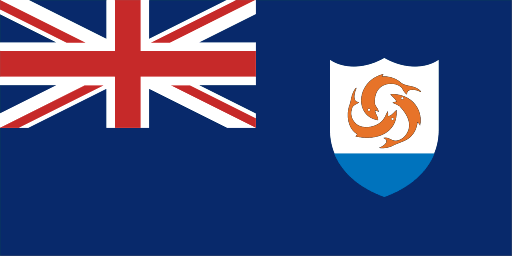
image by Graham Bartram, 25 Apr 2004

Last modified: 2015-08-18 by zoltán horváth
Keywords: anguilla | union jack | dolphin | ensign | governor | error | dolphin |
Links: FOTW homepage |
search |
disclaimer and copyright |
write us |
mirrors

image by Graham Bartram, 25 Apr 2004
Anguillans seem to regard the “Three
Dolphins” flag as their “real” flag, and it
tends to be flown much more frequently than the official flag, especially
in private residences, shops, etc.
Ron Lahav, 23 Feb 2005
Photo of a real flag at
http://net.ai/ezimagecatalogue/catalogue/variations/488-450x500.jpg show a
much bigger defacement, no gold border to the shield, and darker dolphins.
Dov Gutterman, 13 July 2005
The photo is confirming what I wrote (in some detail) to the list a couple of months ago, and both (as I said at the time) "may be confirmed at the Government website" on http://www.gov.ai/flag.htm. Christopher Southworth, 13 July 2005
The flag was concurrent with the grant of arms by Royal Warrant dated 27
November 1990, and first officially raised on the 29th. As I understand it,
prior to this the official flag of the territory was the Union Flag? The
"official" design of the flag is set in London and not by the local authorities,
so the 'correct' flag is actually that shown on Graham's website. It is,
however, perhaps worth remarking that the style of 'dolphins' as portrayed by
Graham would appear close to indentical to those originally used on the island
flag of 1967 (at least as shown by Pedersen and by Crampton)? The
seal we show currently seems accurate, but the shield
on it is supposed to be different to that on the flag.
The Anguilla Blue Ensign (annoyingly) did not appear in BR20 prior to Change No.
5, but several others did of course, and Bermuda and the
British Virgin Islands (as two examples) showed badges the
regulation 4/9 in height. Prior to the changes Graham made in 1999, however, 4/9
was the regulated size so it is reasonably safe to assume that Anguilla was no
exception.
Christopher Southworth, 15 July 2005
According to Nick Weekes' "Colonial Flag Badges", the defaced flags were
taken into use on 30 May 1990, but were not authorized until 27 November 1990.
Recorded at the College of Arms in I Series Volume 84 page 312, under authority
of Royal Warrant 27 November 1990.
I agree with Christopher that there is no reason to suppose that Anguilla did
not have a badge of 4/9ths size before 1999. Some might still be in use.
David Prothero, 15 July 2005
On 1 February 1980 Anguilla
became a separate crown
colony and later adopted the blue ensign with the
former flag as a sort of
badge.
Mark Sensen, 26 Oct 1996
The current flag — blue ensign with dolphin badge — was
adopted on May 30th,
1990.
Nozomi Kariyasu, 10 Jul 1999
A previous Governor of Anguilla, Mr. Brian Canty, suggested a new flag
and drew sketches which were sent to London for approval by Her Majesty the
Queen. The new flag, which was first hoisted on
30 May,
1990, is a blue
ensign with a Union Jack in the top left corner and a shield on the right
side which shows three orange dolphins on a white background with a
turquoise-blue base. The design thus incorporates affiliation to Britain and
the Anguilla Three Dolphins flag.
Dov Gutterman, 02 Mar 2002, quoting from
www.gov.ai/flag.htm
The British Navy flag book’s Change No. 5 of 1999
and the current issue of BR20 [gra00]
shows the badge at 13/24, not 4/9 any more. There is no gold border to the
shield as it appears on the flag (it only appears on the seal and inside the
garland of the Governor’s flag). The proportions of
the shield, according to BR20 should be 5/4. The shield is straight
sided until 15/26 of its depth and the light blue occupies 4/13 of the overall
size.
Christopher Southworth, 30 Apr 2005
The coat of arms of Anguilla has a bottom stripe of
light tourqoise-blue. In the flag that stripe is light blue. The reason: the
Goverment of Anguilla could not afford the money for flags with a correct
shield, as the special shade of bluish-green would have risen the costs for
the flags. So the manufacturer decided to make the shield white and blue to
keep the costs lower.
Ralf Stelter, 10 May 1999
I forwarded the correspondence about the flags of Anguilla to Nick Weekes,
who wrote:
"In an attempt to simplify this issue, may I suggest that the College of Arms
must be credited with ultimate responsibility for the design of the Arms of Anguilla and of the defacement of the Anguilla Blue Ensign (the latter
incorporating the shield of the Arms and recorded at the College). See the
relevant detail within Annex A to my Flag Research Note No 2: (available online
to members of the Flag Institute)
Anguilla. (Flagmaster 082 and Flag Bulletin 143.)
(1) Grant of Arms by Royal Warrant dated 27 Nov 1990.
(2) Concurrent authorization of defacement of Blue Ensign with shield of Arms
(no background disc) (recorded at College of Arms in I Series Volume 84, p. 312
under authority of Royal Warrant; 27 Nov 1990).
(3) Union Flag defacement (circular configuration of design on shield within
garland) also taken into use in 1990.
(4) Defaced flags actually taken into use on 30 May 1990.
(5) No authorization of Red Ensign defacement.
Garter (and the Governor in his petition to Garter) may well have taken into
account symbology in use or purportedly in use previously. But the College would
have made the final decision on the design submitted to Her Majesty for approval
in the form of a painting prepared by an heraldic artist. Assuming that Her
Majesty signed off the painting that became page 312 of Volume 84 without
requiring modification, she was in effect approving the design of a new flag as
submitted by the College through the Earl Marshal. I imagine that the purported
use of the flag from 30 May 1990 was because the design was not controversial
and Her Majesty's approval was anticipated. She eventually signed off the
painting that became page 312 of Volume 84 and the Royal Warrant concerning the
grant of Arms on the same day (27 November 1990), as one might expect. As the
design of the Blue Ensign defacement was derived from the Arms, the College
would not have wished to submit the proposed flag for approval in advance of
submitting the draft of the Royal Warrant."
David Prothero, 14 November 2011
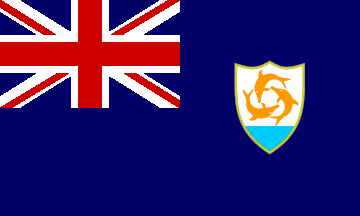
image by Gvido Pētersons and António Martins, 15 Nov 2000
The Foreign and Commonwealth
Office wrote, that the blue ensign is used
in 3:5 ratio on land
and in 1:2 ratio at sea.
On land this flag is the
“unofficial” National flag, to be used
for decorative and distiguishing
purposes inside and outside Anguilla
(the official state flag is the
Union Jack).
The blue ensign
on land is not as unusual
as one might expect.
St. Vincent
used it with her
own arms as National flag on land, too.
Ralf Stelter, 25 Jul 1999
A 3:5 version of the ensign is then prescribed,
to be used in those occasions when a specific anguillan
symbol is needed (I guess this happends when the UJ is
flown standing for Britain, like in Commonwealth
meetings or during the odd british VIP official visit to
the island).
António Martins, 24 Oct 1999
Anguilla is 1:2, not 3:5. I quote BR20
[gra00]
as my authority on this one, and although it recommends
(excepting the Union Flag) 3:5 for
land flags, it also says that flags with a
Union in the canton should
(even though the Union Flag can be made
in 3:5) always be 1:2.
Christopher Southworth, 07 Dec 2004
Is it possible that Ralph saw one or more 3x5 Anguilla flags flying on the
island and thus assumed the proportions might be 3 to 5?
In recent years, a large number of American made British territorial flags have
turned up in several of the British possessions. The American product is fairly
high in quality at only a fraction of the cost of a British made flag or ensign.
Annin flags and others fairly common in Bermuda, BVI, and the Cayman Islands.
Maybe the same can be said for Anguilla, and thus an honest reporting mistake??
Clay Moss, 01 June 2005
It is possible (Ralf, are you there?!), but then he would say so and not
claim that the Foreign and Commonwealth Office had written (to him) saying so.
I'm inclined to asume that this is either a valid prescription at the time,
meanwhile superceded by the practice described by Graham, or an incorrect
information issued from the said Office, or a misinterpretation by Ralf.
António Martins-Tuválkin, 02 June 2005
Since the proportions of the UJ on land (as prescribed by the British Army)
are 3:5 rather than 1:2, it seems not at all unlikely that Anguilla could also
have two different flag ratios depending on which governmental organization is
buying and using the flags.
Joe McMillan, 02 June 2005
I can find no legislation as such and can only repeat that officially a 3:5
variant doesn't exist, however (and having said that), I have no idea if such a
flag was ever tried and then abandoned at some earlier date?
Christopher Southworth, 15 July 2005
.gif)
image by António Martins-Tuválkin, 20 July 2005
The official seal is the shield with a double circle around
it containing the words Anguilla: Strength and Endurance.
Gvido Pētersons, 07 Nov 2000, quoting the
government website
The coat of arms of Anguilla has a bottom stripe of light
tourqoise-blue.
Ralf Stelter, 10 May 1999
A new and better image is made from the large sized
image in a Flash movie at http://www.gov.ai/.
António Martins-Tuválkin, 20 July 2005
3d'.gif)
image by António Martins, 20 July 2005
If so, then it was unfortunate, as that design aprt from not looking half as
good as the one currently used in the Anguila national emblem/seal, it is not
even geometrically correct lack accurate rotational symmetry. (FWIW, the $1
postage stamp at http://www.gov.ai/flag.htm
shows yet another design with "fatter" dolphins.)
The three dolphins as depiced in [ped71b] and [cra89].
António Martins-Tuválkin, 20 July 2005
In addition to these, however, (which I should have mentioned before) I have
a specification for the island flag drawn up by William in April 1995. On this
last he shows the 'dolphins' in the same style as used by Graham and illustrated
in Pedersen, but whilst the spec calls for these dolphins to be within a circle
(centred on the white stripe) with a diameter equal to three-fifths of flag
width or (4/5 the white stripe) they are actually illustrated in a flattened
ellipse of what looks like the same proportions as that on my own spec? This
leads me to speculate whether Graham actually used Dr Crampton's illustration
when preparing Change No 5 to BR20?
Christopher Southworth, 20 July 2005
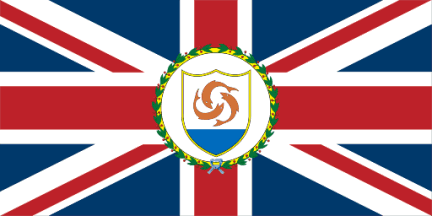
image by Graham Bartram, 25 April 2004
As I understand it, the yellow shield “border”
has a black fimbriation to delineate the shield.
Paige Herring, 25 April 2004
The Governor’s flag has a gold edge to the shield, but
the Blue Ensign does not.
Graham Bartram, 20 December 2004
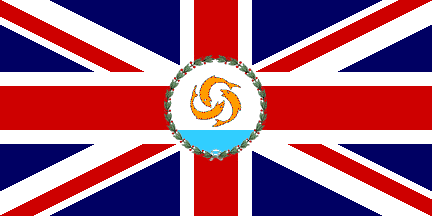
image by António Martins-Tuválkin, 20 July 2005
The Anguillan governor has a flag. It’s a Union Jack with a
white circle in the middle. In the circle is the white and blue
badge with the three orange dolphins. Same as on the flag image.
Inside the circle and outside of the badge are two laurel
branches that start below the badge and finish above the badge.
The tips of the branches do not touch nor do the bottoms. There
is some sort of decoration between and touching the bottoms of
the laurels, but I didn’t get close enough to see what it was.
Sally Janin, 30 July 1997
It is a normal British
oversea’s governor flag.
Armand du Payrat, 08 Dec 1999
The refered «decoration between and touching the bottoms of the
laurels» is evidently a lace of sky blue ribbon.
From the description above («Inside the circle and outside of the
badge»), it is clear that locally used flags do have the laurel
garland completely inside the disc, and not over it’s edge.
António Martins, 19 Jan 2000
The governor's official flag comprises the Union Jack and the Anguilla coat
of arms surrounded by a laurel wreath. It is flown at Government House when the
Governor is in residence and on any motor car or boat in which he is making an
official visit. The coat of arms uses the same dolphin design that appears on
the flag and is edged with gold.
Gvido Pētersons, 07 Nov 2000, quoting the
government website
Described in "Colonial Flag Badges" as, "Union Flag defacement (circular
configuration of design on shield within garland) also taken into use in 1990."
David Prothero, 15 July 2005
Described in Colonial Flag Badges [wee02] as
Union Flag defacement (circular configuration of design on shield within garland) also taken into use in 1990.This is rather obscure, but I am sure that it means that the design on the shield was enlarged to fill the whole of the circular space within the garland, as in the Governor's Flag on the Anguilla web page.
The original governor's flag, but the
dates would have been 1990 - 1999. A governor was appointed in 1983, but there
appears to have been no special flag for him until 1990.
David Prothero, 21 July 2005
red pierced black

image by Antonio Martins, 15 Aug 1999
red pennant
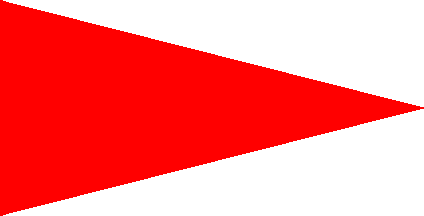
image by Antonio Martins, 15 Aug 1999
According to the WMO book [c9h07], Anguilla, mentioned under the heading of St Kitts and Nevis, uses the same flags which implies partial use of the well-known US signal set:
(The fourth item of the set i.e. 39a (double set of red pennants)
is not used.)
Jan Mertens, 23 Mar 2008